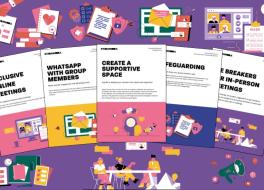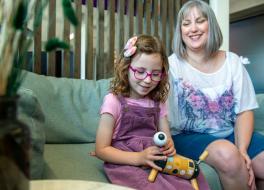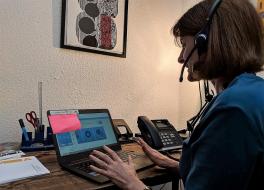Learn about the range of mobile apps and devices for stammering support.
Are you looking for something you can do yourself to help with stammering? One option is to download an app or buy a fluency device.
What's on the market, how do they work and how effective are they? Find out below.
Please note: the list of apps and devices we mention isn't comprehensive. The fact we've included them doesn't necessarily mean we endorse them.
Want to chat about anything on this page? Start a webchat or call our free helpline on 0808 802 0002.
What are stammering apps & devices?
There's a range of apps and electronic devices to help with stammering. A lot of them aim to increase fluency.
You can download these apps to your smartphone or you can buy a fluency device. These come in the form of small handheld boxes with wired earphones, or in-ear devices that look like hearing aids.
Then there are apps that do different things, like monitor speech. This can help identify areas you might want to work on. Others give you breathing and meditation exercises, or tips and strategies for parents. Some apps offer a combination of increasing fluency with some of the above features.
You can use apps and devices on your own. Or, if you're seeing a speech & language therapist, you could ask about incorporating them into therapy.
List of available apps
Apps that aim to increase fluency
- DAF Pro. This uses a technology called 'Delayed Auditory Feedback' (DAF). Read all about this below.
- EasySpeak - DAF Speech Fluency. (Android-only).
- Stamurai. As well as aiming to increase fluency, this lets you practise reading aloud. It also gives guided meditation and breathing exercises.
- Speech Pacesetter. (Apple only). For practising speaking in a slower style. Some people say they feel more comfortable to navigate moments of stammering when speaking slowly. If that's you, you might find this useful. It's aimed at speech & language therapists to use with service users, but some people might find it useful. It costs £17.99. Read the story behind the app on the makers' website.
Other apps
- BeneTalk
This app doesn't aim to increase fluency, but it uses technology to monitor speech. It gives you feedback in real time. The aim is to help you make changes to your speech. For ages 8+.
App for parents
- Penguin — Support for Stammering
This app is a 10-day programme for parents whose child has started stammering. Each day has a short video with a task to help reflect on your situation. It then helps set up strategies to support yourself and your family.
Penguin is used by quite a few NHS Speech & Language Therapy departments too. Read an article from Jaclyn, a therapist who was involved in creating the app.
List of available devices
Electronic fluency devices are an alternative to apps. As their name suggests, they just aim to increase fluency.
These have been around since the late 1970s, with the 'Edinburgh Masker' being a popular early device. This has since been discontinued.
Devices are a lot more expensive than apps and harder to purchase. But they have some advantages — see Devices Pros & Cons below. Also, see how you might be able to get help paying for a device.
Here's what's on the market:
- Casa Futura Technologies. This U.S. website sells a catalogue of devices. Most of them are available to customers in the UK.
- SpeechEasy. In-ear devices. They are not available for UK customers but they do offer free fluency software you can download to your computer, called Fluency Coach. Listen to an episode of the StutterTalk podcast all about SpeechEasy.
- Speak For Less. In-ear devices available to U.S. customers only.
How do fluency apps & devices work?
Apps and devices that aim to increase fluency use a technology called 'Altered Auditory Feedback' (AAF).
Here's how it works. You put in earphones and open the app/turn the device on. Then, whenever you speak, you hear your voice played back with an added effect.
Here are the different types of effects:
Delayed auditory feedback (DAF)
With this type, when you speak you'll hear your voice played back with a slight delay. This is called 'Delayed Auditory Feedback' (DAF). It kind of feels like you're speaking along with someone else. Some people find they stammer less while doing this. It's a phenomenon called 'the choral effect'.
Frequency-shifted Auditory Feedback (FAF)
Some apps and devices may let you change the pitch of your voice when hearing it back. This is called 'Frequency-shifted Auditory Feedback' or FAF.
Masking
Some apps produce a humming sound while you speak, sometimes called 'white noise'. This 'masks' your voice. Again, some people find this makes them stammer less.
Are they effective?
Like with all approaches to stammering, apps and devices are helpful for some people but not others. Some apps, and/or app settings, may be more effective than others. Any useful effects might last for some people and fade with time for others. Each person is likely to respond differently.
It's important to remember that apps and devices won't cure stammering. See our page Is There A Stammering Cure? for more on this (spoiler: there isn't one). But if you're looking for something to get you through a worrying situation, they might be for you.
Supporter experiences
Using a fluency app helped with my confidence.
Also, read Dave's article 'Getting through my Father of the Bride speech'. In it, Dave (pictured below) tells us how using a device helped him.

Apps pros & cons
Pros
- Apps are significantly cheaper than buying a device.
- They can offer a wider range of features than devices, which just use the AAF technology.
Cons
- Using apps can be tricky in loud environments. Regular earphones might struggle to pick up just your voice and cancel out background noise.
- Using bluetooth earphones can have latency (delay) issues, so wired earphones tend to be better with apps.
- Apps may or may not be effective during telephone calls. Look at the app description and reviews, but ultimately you'll need to test it on your phone.
Devices pros & cons
Pros
- An advantage of devices over apps can be their higher technical and sound quality. This might make them more effective. For example, they come with a specialised microphone, earphones and technology. This can be better at picking up your voice and rejecting background noise than using your phone.
- Devices might be an option if you don't have or want a smartphone. Or if you want to use something separately from your phone.
Cons
- Devices are sold by companies in the U.S. and only one of those listed below ship to the UK.
- Devices can be expensive. The cheapest device costs over £600 and some sell for thousands of pounds.
- It's also worth noting that devices are only aimed at increasing fluency via the AAF technology. They don't offer features that some apps do, eg speech tracking, exercises and reading practise.
Before spending a lot of money it might be an idea to get advice from a speech & language therapist. See One-to-one Adult Speech & Language Therapy to find a therapist near you.
Help to pay for a device
NHS funding for fluency devices is not generally available. Unfortunately, here at STAMMA we're not able to help with the cost of devices either.
However, you might be able to get some help with costs through the following methods:
Disabled Student Allowances
If you're a student you may be eligible to apply for a Disabled Student Allowance. Contact the Student Disability or Support Service at your college or university to find out more.
Access to Work grants
If you are working, or wanting to start work, you may be able to get funding though the Access to Work scheme. You or your employer may need to pay part of the cost. As well as the Access to Work eligibility criteria, you'll need to have an assessment by a speech & language therapist. You'll also need to have used a fluency device for a trial period.
Via your employer
If you are in work, it may be worth asking your employer if they could provide financial support to pay for a device. This is if it would make a big difference to the way you do your job.
Try these. If you're in work or looking for work, get in touch with our Employment Support Service if you'd like help applying for a device via the methods above.
Is using an app/device the 'right' thing to do?
Some people feel comfortable with their stammer. Some feel proud of their difference. They might view the problem as being the way society doesn't make space for them. Others might not feel so positive, and some might have a mixture of feelings.
There's no right or wrong way for dealing with stammering. It's about what feels right for you.
Again, if you're looking for something to get you through a speaking situation you're worried about, apps or devices might help.
Would you like to talk to us about anything mentioned on this page? Start a webchat or call our free helpline on 0808 802 0002.
More support & information
What next?
- Become A STAMMA Member for free and join the community. We'll keep you updated with our activities.
- Get involved with the STAMMA community. Find an event, fundraise, share your story, volunteer, take part in research and more.
Donate & make a difference
Creating this page was only possible thanks to your kind donations.
Please consider making a donation to STAMMA: click here. You'll be helping us to:
- keep our support services running for people who stammer and worried parents
- put on workshops and support groups
- stage events to bring people together
- create guides for teachers and employers
- create our award-winning campaigns for change.
Thank you.
Our information
Find out How We Produce Our Information.
What did you think of this page? Give us your feedback, we'd love to hear from you.


































